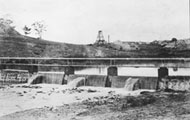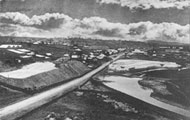- Agriculture
- Object :: Bush repaired Scoop
- Object :: Tumbling Tommy
- Interview :: Murray Smith
- Interview :: Peter Darley
- Windmills, pumps, steam power and engines
- Interview :: Max Jones
- Chaff Cutting
- Object :: Water Barrel
- Object :: Furphy Water Cart
- Ophir
- Object :: Gold Washing Cradle
- Object :: Picks and Mining Pan
- Object :: Chinese Scroll
- Object :: Chinese Shoulder Yoke
- Lucknow
- Historic Cadia
- Water at Cadia Valley Operations
- Interview :: John Ford
- Interview :: Joel Fossilo
- Object :: Testing Apparatus
Lucknow
A few short months after the first gold rush in Australia at Ophir, gold was found at present day Lucknow. Initially the gold source was alluvial, however the Lucknow gold field's wealth lay underground. Mining was hampered during the dry season by lack of available water for use in washing the gold, in working the stamper batteries and for maintaining the steam engines.
The solution was to construct a series of dams along the creek. The bluestone walls of these structures remain a feature of the Lucknow landscape today although the water storage areas have long since silted up. To the east of Emu Swamp Road was a long narrow dam used not for mining, but for recreation. Boating regattas were held on the dam and both men's and women’s rowing teams keenly contested trophies.
The Lucknow gold mines are an extensive and integrated underground series of mines. Although lack of water was initially a problem, by the late 1800s a new problem had arisen – the deep mine lead's began to flood. A rising water table required the mines to be continually pumped out to lower the water level. Today the underground works are totally flooded.
During the recent drought years community interest was shown in again pumping water from the mines, this time for agricultural and domestic use. This didn't eventuate though as the native arseno-pyrite soils of the area have adversely affected the underground water quality.

